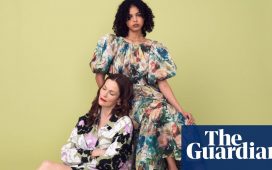From the classic little black dress to a for ever cool biker jacket, black has long been fashion’s last word in chic. “I love black because it affirms, designs and styles,” Yves Saint Laurent once said. “A woman in a black dress is a pencil stroke.” But, in a post-restriction world, even this stamp of approval has been undermined. Because, in 2021, colour is the new black.
Harper’s Bazaar ran a feature titled How Gen Z killed basic black in which writer Isabel Slone argued that “utilitarianism has been replaced with a spirit of experimentation” in fashion. Black, such a useful and versatile staple in wardrobes, is the fall guy. “An all-black wardrobe is no longer shorthand for a mysterious and brooding individual,” wrote Slone. “More and more, it telegraphs that a person is, well, old-fashioned.”
The take-up of colour is widespread. Scroll through any fashionable Instagram feed and you will find influencers dressed in brights ranging from pumpkin orange to primrose yellow, aqua blue, neon pink and grass green, sometimes all in the same outfit. The trend can also be seen in street style and on celebrities –like Rihanna in bright green on a dinner date in New York, and Kim Kardashian in head-to-toe highlighter pink when hosting Saturday Night Live recently. In the 48 hours following Kardashian’s appearance, searches for pink rose 82% on the fashion search platform, Lyst.
Colour is on the catwalk, too. Tagwalk, a fashion search engine which documents catwalk trends, reports that colourblocking at the spring/summer 2022 shows was up 273% compared with the previous year. Gucci’s Love Parade show in LA was a veritable rainbow of pinks, yellows and reds, while Kelly green – a shade similar to Rihanna’s coat and also found in collections of brands ranging from Rejina Pyo to Bottega Veneta – has been declared “the colour of now” by Elle magazine.
This shift away from black is partly down to easing of restrictions in most countries. Colour expresses joy and allows its wearer to look dressed up – an appealing concept after 18 months at home in grey marl sweatpants.
Fashion psychologist Dr Dawnn Karen said that “people are dressing for their best life” and this comes with a certain abandon. “We’re going to layer that clash. ‘I’m going to put this on, don’t care if it matches’,” she said. “They are receiving that internal validation. We no longer are looking towards others, we’re looking towards ourselves.”

The rise of colour in fashion also reflects the celebration of personal style that dominates fashion now, particularly online. Rosanna Falconer, a brand consultant and co-founder of FashMash, is known to her followers on Instagram for brightly coloured outfits.
She says fashion’s embrace of colour “started with the digital revolution. A pink dress photographed much better for e-commerce than a black one.” But, while screen pixilation means this has been rectified, colour still stands out. “A colourful design conveys so much more in a 10-second TikTok video and might just stop the scrolling and result in a like,” she said.
Wearing colour isn’t just about gaining attention, though. It can be a way to boost your own mood, at a time when uncertainty remains. “People are trying to dress themselves happy,” said Karen, “because of that uncertainty, that anxiety, that melancholy.”
Falconer also believes in the power of colour to make its wearer feel better. She says she wears it “as much for the effect it has on those around me as the effect it has on me… on dull grey autumn days it’s tempting to cocoon away in neutral colours. But I promise, even 10 minutes in a bright colour tricks the mind into a better day.”
Influencer Nicole Ocran describes herself as “a pink person” and her Instagram account features yellow, orange and green and lilac. She says black, for her, recalls an older idea of fashion based around rules. “In the era of fashion that I grew up in, it was definitely associated with like, ‘this is the only way you can be chic’, and , minimal wardrobes.” Now, she steers away from black: “It feels a little bit too safe. I’m in this this kind of stage of my life where I want to be more playful.”













